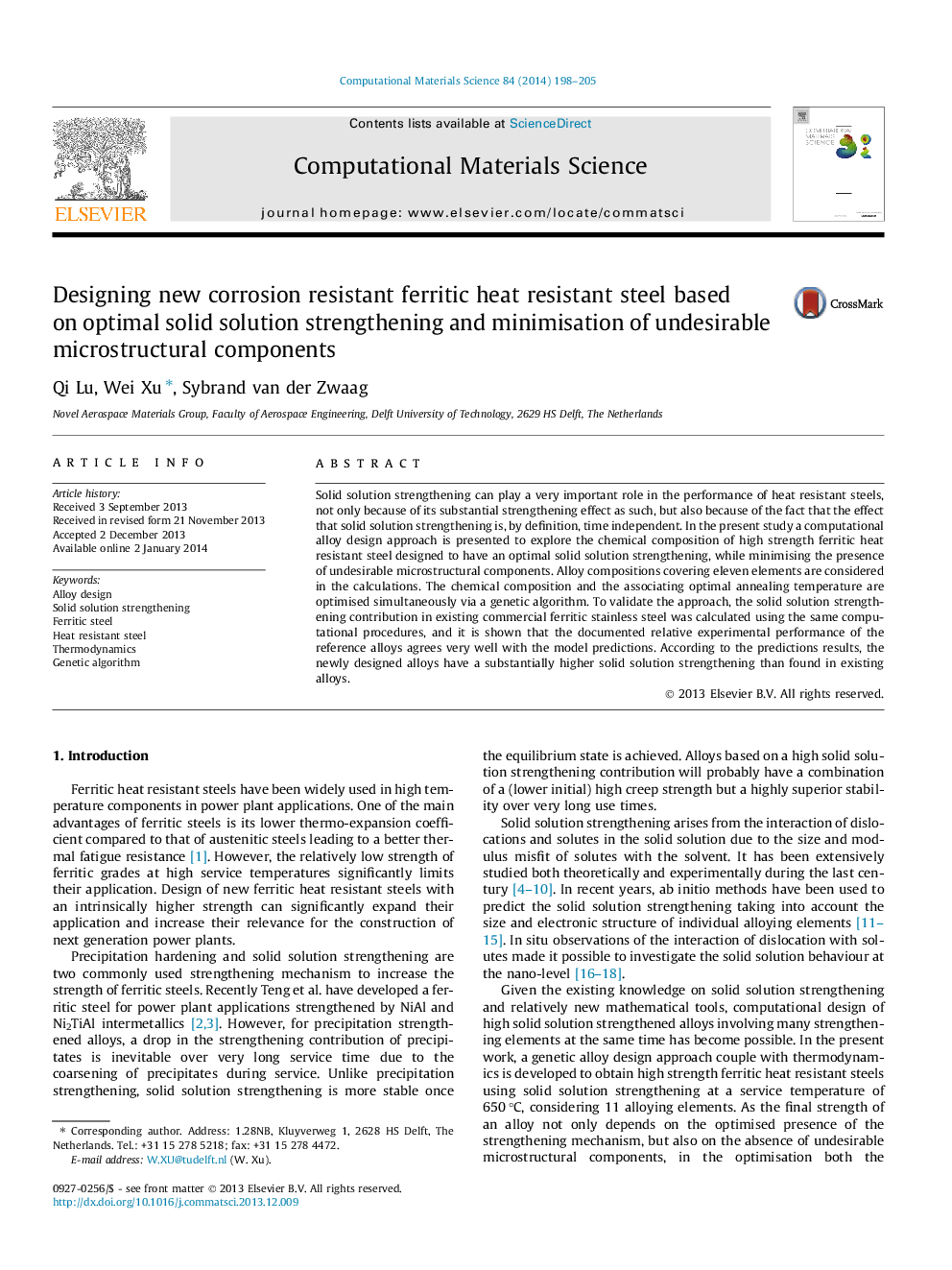| کد مقاله | کد نشریه | سال انتشار | مقاله انگلیسی | نسخه تمام متن |
|---|---|---|---|---|
| 7960691 | 1513925 | 2014 | 8 صفحه PDF | دانلود رایگان |
عنوان انگلیسی مقاله ISI
Designing new corrosion resistant ferritic heat resistant steel based on optimal solid solution strengthening and minimisation of undesirable microstructural components
ترجمه فارسی عنوان
طراحی مقاوم در برابر فولاد مقاوم در برابر خوردگی مقاوم در برابر فولاد فرایتی بر اساس راه حل جامد مطلوب تقویت و به حداقل رساندن اجزای ریز ساختاری نامطلوب
دانلود مقاله + سفارش ترجمه
دانلود مقاله ISI انگلیسی
رایگان برای ایرانیان
کلمات کلیدی
طراحی آلیاژ، تقویت محلول جامد، فولاد فریتی، فولاد مقاوم در برابر حرارت، ترمودینامیک، الگوریتم ژنتیک،
ترجمه چکیده
تقویت حلال جامد می تواند نقش بسیار مهمی در عملکرد فولادهای مقاوم در برابر حرارت داشته باشد، نه تنها به دلیل تاثیر قابل توجهی از تقویت کننده آن، بلکه همچنین به دلیل این واقعیت است که اثر تقویت محلول جامد، بر اساس تعریف، زمان مستقل است. در مطالعه حاضر، یک روش طراحی آلیاژ محاسباتی برای بررسی ترکیب شیمیایی فولاد مقاوم در برابر حرارت از جنس فولاد فریتی طراحی شده است که جهت تقویت محلول جامد مطلوب، در حالی که حداقل اجزای سازندهای نامطلوب میکرو سازنده را کم می کند. ترکیبات آلیاژی شامل یازده عنصر در محاسبات در نظر گرفته شده است. ترکیب شیمیایی و دمای آنیلینگ بهینه سازی به طور همزمان از طریق یک الگوریتم ژنتیکی بهینه می شود. برای اعتبارسنجی رویکرد، مشارکت تقویت کننده راه حل جامد در فولاد ضد زنگ فریتتی تجارتی موجود، با استفاده از روشهای محاسباتی مشابه محاسبه شده است، و نشان داده شده است که عملکرد تجربی نسبی آلیاژهای مرجع با پیش بینی مدل ها بسیار خوب است. با توجه به نتایج پیش بینی شده، آلیاژهای تازه طراحی شده قویتر از محلولهای آلیاژهای موجود در محلولهای جامد هستند.
موضوعات مرتبط
مهندسی و علوم پایه
سایر رشته های مهندسی
مکانیک محاسباتی
چکیده انگلیسی
Solid solution strengthening can play a very important role in the performance of heat resistant steels, not only because of its substantial strengthening effect as such, but also because of the fact that the effect that solid solution strengthening is, by definition, time independent. In the present study a computational alloy design approach is presented to explore the chemical composition of high strength ferritic heat resistant steel designed to have an optimal solid solution strengthening, while minimising the presence of undesirable microstructural components. Alloy compositions covering eleven elements are considered in the calculations. The chemical composition and the associating optimal annealing temperature are optimised simultaneously via a genetic algorithm. To validate the approach, the solid solution strengthening contribution in existing commercial ferritic stainless steel was calculated using the same computational procedures, and it is shown that the documented relative experimental performance of the reference alloys agrees very well with the model predictions. According to the predictions results, the newly designed alloys have a substantially higher solid solution strengthening than found in existing alloys.
ناشر
Database: Elsevier - ScienceDirect (ساینس دایرکت)
Journal: Computational Materials Science - Volume 84, March 2014, Pages 198-205
Journal: Computational Materials Science - Volume 84, March 2014, Pages 198-205
نویسندگان
Qi Lu, Wei Xu, Sybrand van der Zwaag,
